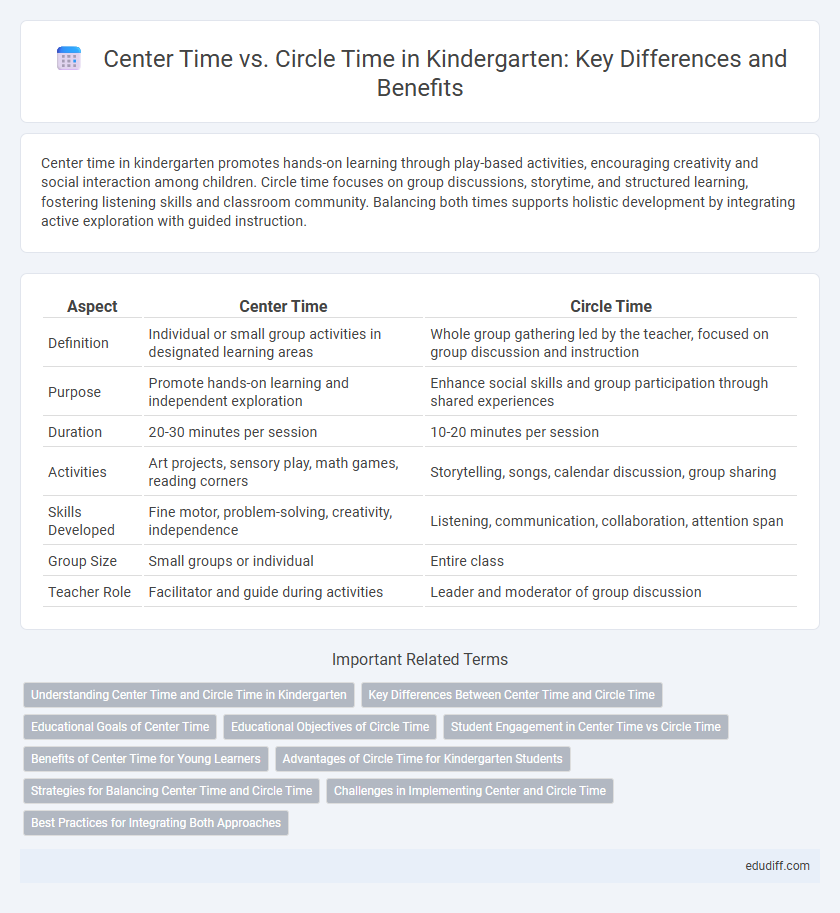Center time in kindergarten promotes hands-on learning through play-based activities, encouraging creativity and social interaction among children. Circle time focuses on group discussions, storytime, and structured learning, fostering listening skills and classroom community. Balancing both times supports holistic development by integrating active exploration with guided instruction.
Table of Comparison
| Aspect | Center Time | Circle Time |
|---|---|---|
| Definition | Individual or small group activities in designated learning areas | Whole group gathering led by the teacher, focused on group discussion and instruction |
| Purpose | Promote hands-on learning and independent exploration | Enhance social skills and group participation through shared experiences |
| Duration | 20-30 minutes per session | 10-20 minutes per session |
| Activities | Art projects, sensory play, math games, reading corners | Storytelling, songs, calendar discussion, group sharing |
| Skills Developed | Fine motor, problem-solving, creativity, independence | Listening, communication, collaboration, attention span |
| Group Size | Small groups or individual | Entire class |
| Teacher Role | Facilitator and guide during activities | Leader and moderator of group discussion |
Understanding Center Time and Circle Time in Kindergarten
Center time in kindergarten involves small groups of students engaging in hands-on activities at different learning stations, fostering independence and cooperative play. Circle time gathers the whole class for group discussions, storytelling, and teacher-led instruction, enhancing social skills and attentive listening. Understanding these key components helps optimize classroom management and supports diverse learning styles in early childhood education.
Key Differences Between Center Time and Circle Time
Center time in kindergarten allows children to engage in hands-on, self-directed activities that promote fine motor skills, creativity, and independent problem-solving, while circle time focuses on group interaction, fostering social skills, listening, and language development through teacher-led discussions and shared experiences. Center time activities are often individualized or small group-based, encouraging exploration within various learning stations like art, blocks, or sensory tables; circle time involves all students seated together, emphasizing communal learning and routine building. The key difference lies in the structure and objectives: center time prioritizes active, autonomous exploration whereas circle time centers on collective participation and teacher-guided instruction.
Educational Goals of Center Time
Center time in kindergarten emphasizes hands-on learning and fosters creativity, problem-solving, and social skills through interactive, self-directed activities. Unlike circle time, which often centers on group instruction and teacher-led discussions, center time allows children to explore educational concepts at their own pace, enhancing cognitive development and fine motor skills. This approach supports individualized learning goals by encouraging collaboration, independence, and critical thinking in an engaging, play-based environment.
Educational Objectives of Circle Time
Circle time enhances social-emotional development, communication skills, and group cooperation by engaging children in interactive storytelling, songs, and discussions. This structured yet flexible setting fosters language acquisition, cognitive growth, and emotional regulation, aligning with early childhood educational goals. Circle time promotes a sense of community and belonging, essential for building confidence and positive classroom behavior.
Student Engagement in Center Time vs Circle Time
Center time promotes higher student engagement by allowing hands-on, self-directed activities that cater to individual learning styles and paces. Circle time, while valuable for group discussions and social skills, often results in passive participation due to its structured, teacher-led format. Research shows that students demonstrate increased focus and enthusiasm during center time, fostering deeper cognitive development and independent problem-solving skills.
Benefits of Center Time for Young Learners
Center time in kindergarten fosters hands-on learning, allowing young learners to explore materials and concepts at their own pace, which enhances creativity and problem-solving skills. It supports social development as children collaborate with peers, practice communication, and develop empathy in small group settings. This individualized and interactive approach promotes deeper engagement and reinforces foundational skills in literacy, math, and fine motor coordination.
Advantages of Circle Time for Kindergarten Students
Circle time in kindergarten enhances social interaction and communication skills by encouraging students to share ideas and listen actively in a structured group setting. It fosters a sense of community and belonging, promoting emotional development and cooperation among peers. The routine nature of circle time also supports cognitive growth by helping children understand sequences and improve attention span through engaging activities.
Strategies for Balancing Center Time and Circle Time
Effective strategies for balancing center time and circle time in kindergarten include structuring daily schedules to allocate specific time blocks that promote engagement and transition smoothly between activities. Teachers can use visual timers and clear routines to help children anticipate the shift from interactive circle discussions to hands-on center explorations, enhancing focus and participation. Incorporating flexible groupings and choice-based centers allows differentiation and supports varied learning paces, maximizing developmental benefits during both instructional periods.
Challenges in Implementing Center and Circle Time
Challenges in implementing center time often include managing diverse activity zones to maintain student engagement and ensuring smooth transitions between centers without causing disruptions. Circle time difficulties commonly arise from maintaining students' attention in a group setting, balancing participation, and addressing varied developmental levels within the same session. Both require careful planning, clear routines, and teacher adaptability to meet the dynamic needs of young learners effectively.
Best Practices for Integrating Both Approaches
Center time promotes hands-on learning and individual exploration, allowing children to develop fine motor skills and creativity through interactive activities. Circle time fosters group communication, social skills, and routine-building with structured discussions, songs, and stories that encourage participation and listening. Combining center time and circle time optimizes early childhood development by balancing independent exploration with collaborative learning in a kindergarten setting.
Center time vs Circle time Infographic

 edudiff.com
edudiff.com